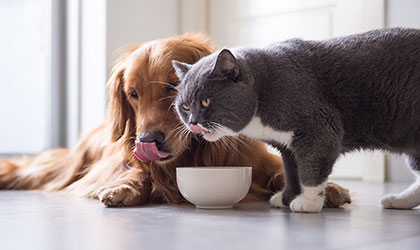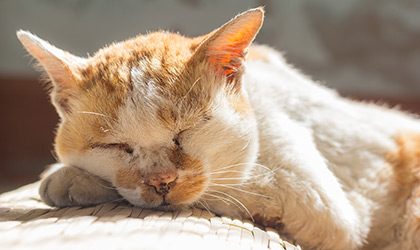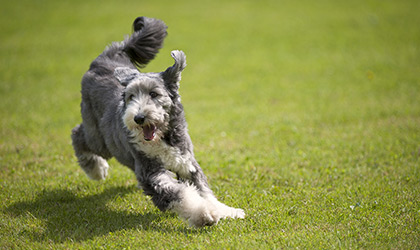
Healthy coats
Did you know your pets mane provides a useful window into their overall health and wellbeing? An irresistibly silky-smooth coat signals your companion is in ship-shape, while a flaky, scaly and inflamed skin is an indicator of an ailing animal, or rather the absence of a healthy diet and regular grooming sessions.
Diet
To achieve that handsome glow and lustrous sheen, your furry friend needs a diet rich in essential fatty acids (omega 3, 6 & 9). Always choose pet food products that contain adequate levels of these skin loving compounds, as well as other nourishing nutrients like vitamin A, biotin, vitamin E and zinc. Feeding your pet a high-strength multi and omega 3 supplements will help plug any nutritional gaps too.
Grooming
Often to their owners’ dismay (especially if a pristine white carpet is involved), pets love getting paws-deep in dirt. It’s part of their endearing charm, right? But rolling around in the mud, jumping through long grass, or nose-diving into lakes can lead to build-up of allergens, pollen and dirt in your pet’s fur – an invitation for fleas and critters to nest. The solution? Regular grooming. Just like us, cats and dogs need grooming to keep them clean, fresh and smelling like roses (well, almost).
Bathing
Though cats are pretty much exempt from this rule (just look at all that time they spend cleaning themselves), our canine companions most definitely are not. You should bathe dogs every 2-3 months, however, this can vary based on breed and lifestyle. Double-coated breeds, such as Golden Retrievers, only need a thorough scrubbing every 3 months.
Immunity
The secret to your pet’s longevity is a strong immune system – one resilient enough to combat infection lurking in dog parks, vet surgeries or open fields. The best defence is a good offence, right?
Diet
Feeding your four-pawed friend a diet brimming in nutrients (vitamin A, B vitamins, vitamins C and E, zinc, selenium, and vitamin D) is the key to maintaining a balanced and healthy immune system. By combating destructive free radicals, antioxidants keep your pet’s immune system on its A-game. Adding a high-strength multivitamin will support immunity too.
Exercise
Not only does physical activity make for a happy pet, it makes for a healthier one too. Alongside a number of other health benefits, exercise keeps your little animals immune system fighting fit. When your furry friend utilises his muscles, it helps the lymphatic system work well, and thereby flushes the body of toxins. For this reason, and many others, exercising your pet every day is the secret to optimal health.
Stress
Did you know stress can reduce your beloved companion’s ability to ward off disease? Yep, research suggests decreasing the stressors in your pet’s life can bolster his immunity. To keep cortisol levels low, try reducing all forms of stress in your household. Perhaps you could create a ‘chill out’ area for your pets – a safe-space free from any anxiety-inducing stimuli such as loud appliances, strong smells or bright lights. Somewhere such as a bed underneath the stairs, and for cats, a cosy bed high up away from the clatter of daily life.
Teeth and gums
You may not already know it but looking after your furry friend’s pearly whites will help contribute to a longer and more fruitful life. Since gum disease is so rife in the pet population, dental hygiene is something you should take very seriously as an owner. Teeth cleaning -If regular brushing isn’t part of your pal’s routine, there’s no better time to start than now. Daily brushing can reduce a build-up of plaque and the foul stench of bad breath (which can leave even the most doting owners gasping for air!) Opt for a specifically formulated toothpaste and toothbrush and always ask your vet for guidance before you begin. Oh, and never use human toothpaste because it contains chemicals that will make pets sick.
Diet
When it comes to your animal’s oral health, dry food is generally better than its canned counterpart. This is because kibble scrapes teeth, removes bacteria, and lessens the build-up of tartar. A diet rich in the micronutrient, vitamins A, B complex, C and E with zinc and manganese will also strengthen periodontal tissue. (Psst...you can find these essential compounds in our pet multivitamins!
Dental treats - Not just reserved for rewarding good behaviour, dental treats improve your companion’s gnashers too. From edible bones to chewable sticks, these snacks support healthy gums, reduce plaque and keep breath fresh. Just make sure that you include them in your animal's daily calorie intake.
According to the American Veterinary Dental College, gum disease is the most common clinical condition in adult dogs and cats.
Claws
Although most pets don’t need their claws trimmed regularly, it’s still an integral part of their grooming routine. If your pooch’s nails are getting caught on the floor or making a ‘clicking’ sound when he walks, it’s time for a puppy pedicure. Cats, on the other hand, need their nails clipped every ten days to two weeks. Ask your veterinarian or groomer for advice about what types of nail trimmers are best and how to use them properly. Don’t feel guilty if you can’t do it yourself; it can be a fiddly job, especially if you have a nervy pet on your hands.
Dealing with anxiety
Like humans, pets react to stressful situations – be it storms, fireworks or travel, with many becoming clinging, acting up, or withdrawing. But since we’re not fluent in canine or feline tongue, our four-pawed companions can’t express their feelings in the verbal ways we do. As such, pet parents need to pay attention to the physical and behavioural cues their animal’s exhibit and respond accordingly.
Human affection
Touch and contact help pets (and humans, for that matter) relieve anxiety, fear and stress. For instance, when a dog feels cut off from his owner – his one true best friend, remember – his anxiety levels are likely to soar. Petting and cuddling will help reduce some of that anxiety. Disclaimer: if your four-pawed pal is feeling anxious, it’s important for you to remain calm. Reacting to their anxiety with more anxiety will only exacerbate the situation.
Exercise
Exercise provides a useful outlet to burn off anxiety and tension. In fact, as humans, we’re constantly told that working out relieves stress. Well, taking your dog for a run or playing with your cat works in much the same way. Thanks to flooding the body with feel-good endorphins, physical activity is a brilliant anxiety-buster for your animals.
Essential oils - Used correctly, aromatherapy can be oh-so-soothing for your furry friends. In particular, lavender oil is known to trigger a calming sensation in the brain, and thereby comfort tentative pets.
Did you know?
Some vet surgeries diffuse lavender essential oil to reassure anxious pets.
Supporting mobility in old age
As your beloved friend ages, he may not be as quick on his four paws. His joints will probably stiffen and he could experience difficulty moving. But isn’t age just a ‘number’? And aren’t you only as old as you feel? Whatever your thoughts on ageing, you’ll be glad to hear there are still plenty of ways to keep your little fur ball mobile well into old age.
Weight
Keeping your pet slim is more important than ever in old age. Excess weight will only aggravate already-stiffening joints. For this reason, it’s crucial your companion continues to eat a well balanced diet – one packed with tons of nutritional goodness. Unsurprisingly, unhealthy titbits and table scraps are off the menu (yes, even that innocent morsel of cheese).
Easy does it
Ageing can trigger all sorts of nagging aches and pains for your pets (the joys of getting old, eh?) The good news is that a low-stress environment is one sure-fire way to support your furry friend’s mobility. Use ramps to help dogs get in and out of the car. Put down secure rugs to help older pets as they walk. And provide your ageing friends with soft, supportive bedding. Another big no-no: don’t be tempted to throw balls for pooches with sore joints. This will only tempt them to run and could unnecessarily strain their problem areas. Controlled exercise is a must, sadly.
TLC
This is the stage of life where a good ol’ dose of TLC really does go a long way. A professional animal massage therapist may help improve your pet’s circulation, flexibility, and mobility. You could even consider hydrotherapy for dogs. The buoyancy of the warm water will help to reduce swelling and pressure on joints.
Never hesitate to consult your vet if you’re unsure about your pet’s health condition.
You Might Also Like

Keri
Keri Filtness has worked in the Nutrition Industry for 19 years. She is regularly called upon for her professional comments on health and nutrition related news. Her opinions have been featured by BBC3, Prima, Vitality, The Mirror, Woman’s Own and Cycling Weekly, amongst others. She has also worked one to one with journalists, analysing their diets and health concerns and recommending changes and additions, where appropriate.
View More



